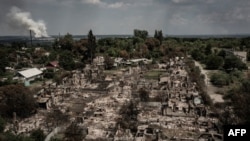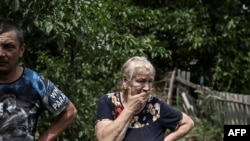Russia now controls about 80% of Ukraine's eastern industrial city of Sievierodonetsk and has destroyed all three bridges leading out of it, Luhansk regional governor Serhiy Haidai said Tuesday.
With Russia's destruction of bridges, Haidai acknowledged that a mass evacuation of civilians from Sievierodonetsk now is "simply not possible" because of Moscow's relentless shelling and fighting in the city.
He said Ukrainian forces have been pushed to the outskirts of the city because of "the scorched earth method and heavy artillery the Russians are using."
But Haidai told The Associated Press that Russian forces had not blocked off access to the city, leaving Ukraine with "an opportunity for the evacuation of the wounded, communication with the Ukrainian military and local residents."
About 12,000 of the city's original population of 100,000 remain, with 500 civilians sheltering in the Azot chemical plant, which is being shelled by the Russians.
Russian Colonel-General Mikhail Mizintsev said a humanitarian corridor will be opened Wednesday to evacuate civilians from the chemical plant, but that they will be taken to the town of Svatovo, which is under control of Russian and separatist forces.
Slowly, but relentlessly, Russia appears to be gaining the upper hand in the fight for control of the Donbas region, which encompasses the Luhansk and Donetsk provinces of Ukraine that Russia recognizes as independent states.
"The situation is difficult," Ukrainian President Volodymyr Zelenskyy said at a news conference Tuesday with Danish media. "Our task is to fight back."
Zelenskyy said the battle for the Donbas region "will surely go down in military history as one of the most violent battles in Europe."
"For us, the price of this battle is very high. It is just scary," Zelenskyy said late Monday.
He repeated a call for partner countries to send Ukraine modern artillery to use against Russian forces.
Zelenskyy’s adviser, Mykhailo Podolyak, said Monday that Ukraine is waiting for a decision on more military aid as participants in the U.S.-led Contact Group meet Wednesday at NATO headquarters in Brussels.
Podolyak, tweeted that “to end the war we need heavy weapons parity.” He listed several categories of weapons, including 1,000 howitzers, 300 multiple launch rocket systems, 500 tanks, 2,000 armored vehicles and 1,000 drones.
U.S. Defense Secretary Lloyd Austin is convening the meeting at NATO headquarters. A virtual meeting of the group last month drew representatives from 47 countries, NATO and the European Union.
Austin said after the May talks that the group was “intensifying our efforts” and working to deepen coordination with Ukraine “so that Ukraine can sustain and strengthen its battlefield operations.”
Britain’s defense ministry said Monday that in recent days the battle around Sievierodonetsk “has continued to rage.”
The ministry said Russia’s ability to carry out river crossing operations will likely be one of the most important factors in the war in the coming months.
“To achieve success in the current operational phase of its Donbas offensive, Russia is either going to have to complete ambitious flanking actions, or conduct assault river crossings,” it said.
Russia claims it already controls 97% of the Luhansk province where Sievierodonetsk is located. But capturing the industrial city of Sievierodonetsk, with a prewar population of 100,000, remains crucial to Moscow’s broader goal of controlling the eastern Donbas region, which encompasses the Luhansk and Donetsk provinces.
Russia seized Ukraine’s Crimean Peninsula in 2014 and Kyiv’s forces have been fighting pro-Russian separatists in the Donbas region since then.
Some material in this report came from Reuters, The Associated Press, and Agence France-Presse.











